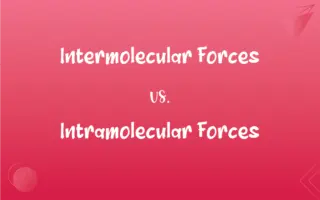Primary Amines vs. Tertiary Amines: What's the Difference?
Edited by Aimie Carlson || By Harlon Moss || Updated on October 26, 2023
Primary amines have one alkyl or aryl group attached to the nitrogen, while tertiary amines have three.

Key Differences
Primary amines contain one carbon-nitrogen single bond, while tertiary amines have three carbon-nitrogen bonds.
In primary amines, the nitrogen atom is bonded to one carbon and two hydrogens, whereas in tertiary amines, it's bonded to three carbon atoms.
Primary amines have higher boiling points compared to tertiary amines due to the presence of hydrogen bonding.
Tertiary amines are typically more sterically hindered than primary amines, affecting their reactivity and usage in chemical synthesis.
Primary amines can undergo further alkylation to form secondary and tertiary amines, but tertiary amines cannot be further alkylated without changing the nitrogen's hybridization.
ADVERTISEMENT
Comparison Chart
Alkyl Groups
One alkyl or aryl group
Three alkyl or aryl groups
Hydrogen Atoms
Two hydrogens bonded to nitrogen
No hydrogen bonded to nitrogen
Boiling Point
Higher due to hydrogen bonding
Lower due to lack of hydrogen bonding
Steric Hindrance
Less sterically hindered
More sterically hindered
Further Alkylation
Can be further alkylated
Cannot be further alkylated
ADVERTISEMENT
Primary Amines and Tertiary Amines Definitions
Primary Amines
Amines where nitrogen is bonded to one carbon.
Ethylamine is a primary amine used in pharmaceuticals.
Tertiary Amines
Amines with no hydrogen atoms bonded to nitrogen.
Tripropylamine, a tertiary amine, lacks hydrogen on its nitrogen atom.
Primary Amines
Less sterically hindered amines.
Butylamine, a primary amine, reacts readily due to less steric hindrance.
Tertiary Amines
More sterically hindered amines.
Tributylamine, a tertiary amine, shows reduced reactivity due to steric hindrance.
Primary Amines
Amines with two hydrogen atoms bonded to nitrogen.
Propylamine, a primary amine, is used in chemical synthesis.
Tertiary Amines
Amines where nitrogen is bonded to three carbons.
Triethylamine is a tertiary amine used as a catalyst.
Primary Amines
Amines capable of further alkylation.
The primary amine, hexylamine, can be converted to a secondary amine.
Tertiary Amines
Amines that cannot be further alkylated.
The tertiary amine, trihexylamine, cannot undergo further alkylation.
Primary Amines
Organic compounds with one alkyl group attached to nitrogen.
Methylamine is a primary amine used in making pesticides.
Tertiary Amines
Organic compounds with three alkyl groups attached to nitrogen.
Trimethylamine is a tertiary amine with a strong odor.
FAQs
How many hydrogen atoms are bonded to nitrogen in primary amines?
Two hydrogen atoms.
What is a tertiary amine?
An organic compound with three alkyl groups attached to nitrogen.
Are primary amines more reactive than tertiary amines?
Generally, yes, due to less steric hindrance.
Are tertiary amines more sterically hindered than primary amines?
Yes, tertiary amines are more sterically hindered.
Which has a higher boiling point, primary or tertiary amines?
Primary amines generally have a higher boiling point.
Can primary amines undergo further alkylation?
Yes, they can be converted to secondary or tertiary amines.
Can primary amines participate in acid-base reactions?
Yes, they can act as bases.
What is a primary amine?
An organic compound with one alkyl group attached to nitrogen.
Can tertiary amines undergo further alkylation?
No, they cannot be further alkylated without changing the nitrogen's hybridization.
Are primary amines found in nature?
Yes, they are found in various natural sources.
Are tertiary amines soluble in water?
They are less soluble compared to primary amines.
Are there any hydrogen atoms bonded to nitrogen in tertiary amines?
No, there are no hydrogen atoms bonded to nitrogen in tertiary amines.
What's an example of a tertiary amine?
Trimethylamine is an example of a tertiary amine.
Do tertiary amines form hydrogen bonds?
No, they lack hydrogen on nitrogen for hydrogen bonding.
Are tertiary amines common in pharmaceuticals?
Yes, they are used in the synthesis of several drugs.
Do tertiary amines have a higher or lower boiling point than primary amines?
Tertiary amines have a lower boiling point.
What's an example of a primary amine?
Methylamine is an example of a primary amine.
Can primary amines form hydrogen bonds?
Yes, they can form hydrogen bonds.
About Author
Written by
Harlon MossHarlon is a seasoned quality moderator and accomplished content writer for Difference Wiki. An alumnus of the prestigious University of California, he earned his degree in Computer Science. Leveraging his academic background, Harlon brings a meticulous and informed perspective to his work, ensuring content accuracy and excellence.
Edited by
Aimie CarlsonAimie Carlson, holding a master's degree in English literature, is a fervent English language enthusiast. She lends her writing talents to Difference Wiki, a prominent website that specializes in comparisons, offering readers insightful analyses that both captivate and inform.































































